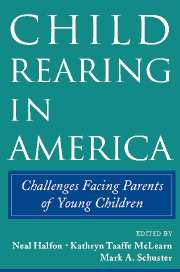Book contents
- Frontmatter
- Contents
- Tables
- Figures
- Contributors
- Acknowledgments
- 1 Introduction and Overview
- PART I CONDITIONS OF FAMILIES WITH YOUNG CHILDREN
- 2 Resources Devoted to Child Development by Families and Society
- 3 Preparing for Parenthood: Who's Ready, Who's Not?
- PART II CHILD-REARING PRACTICES
- PART III DELIVERY OF HEALTH SERVICES TO MOTHERS AND CHILDREN
- PART IV FUTURE DIRECTIONS AND POLICY IMPLICATIONS
- Index
- References
2 - Resources Devoted to Child Development by Families and Society
Published online by Cambridge University Press: 15 July 2009
- Frontmatter
- Contents
- Tables
- Figures
- Contributors
- Acknowledgments
- 1 Introduction and Overview
- PART I CONDITIONS OF FAMILIES WITH YOUNG CHILDREN
- 2 Resources Devoted to Child Development by Families and Society
- 3 Preparing for Parenthood: Who's Ready, Who's Not?
- PART II CHILD-REARING PRACTICES
- PART III DELIVERY OF HEALTH SERVICES TO MOTHERS AND CHILDREN
- PART IV FUTURE DIRECTIONS AND POLICY IMPLICATIONS
- Index
- References
Summary
Both the public sector and families invest heavily in children's development. One estimate of the average total cost of these investments per child is about $16,030 annually (1992 figures, converted to 1999 dollars), or about 15 percent of GDP Haveman and Wolfe (1995). Of the total average spending on a child from birth to age 18, about one-third represents public investment and the other two-thirds, private expenditure. This ratio of public to private investment in children is not constant throughout childhood or across the income distribution. Over two-thirds of government spending on children supports education, which typically does not begin until age 5. Before children enter elementary school, the family is the primary source of inputs into child development.
In recent years, the child development literature has elevated the early years to a new place of prominence in the human life course. Since inputs into early child development are primarily the purview of parents, realizing the potential of early development requires an understanding of parenting behaviors and the contextual factors that influence parents' allocation of resources.
The Commonwealth Survey of Parents with Young Children focuses on families with children in their early years, from birth to age 3. This chapter documents the allocation of resources to child development made by parents, government, and others during this critical period of development. In doing so, we recognize that families' investments in children include not only purchased goods and services but also considerable time.
- Type
- Chapter
- Information
- Child Rearing in AmericaChallenges Facing Parents with Young Children, pp. 21 - 49Publisher: Cambridge University PressPrint publication year: 2002
References
- 2
- Cited by



